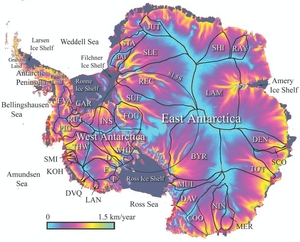Melting West Antarctic Glaciers

An iceberg breaks off the Pine Island glacier (left) into the Amundsen Sea Embayment. This and the Thwaites glacier (right) are two of several glaciers in this area of West Antarctica that are discharging a lot more ice into the ocean than they were 40 years ago. (Credit: NASA)
When NASA issued a warning that some glaciers flowing from the West Antarctic Ice Sheet have entered a state of irreversible decline, the news came as no surprise to climate scientists.
Tim Naish, the director of Victoria University’s Antarctic Research Centre, says the West Antarctic Ice Sheet (WAIS) is partly grounded below sea level, which makes it vulnerable to a warming of the ocean. "There's an inherent instability when you have a large ice sheet sitting in a big over-deepened basin. So if these glaciers ... retreat significantly, it essentially opens up the doorway for the ocean to get in there and get under the ice sheet.
"It's the ocean that's doing the business. It's the ocean warming that is melting these glaciers. They are melting from the bottom up, not the top down."
Tim Naish was a co-leader for the international ANDRILL project, which showed that the WAIS has collapsed several times in the past, some three to five million years ago during a period known to geologists as the Pliocene. The world was three or four degrees warmer then, and carbon dioxide levels in the atmosphere were around 400 ppm, similar to what they are now.
Huw Horgan, also at the Antarctic Research Centre, says the melting could speed up with time. "As we start to remove the bits of floating ice that surround the perimeter of Antarctica, this allows the grounded ice to flow more quickly and we get rid of something called the buttressing effect."
NASA's warning was based on a study that presents multiple lines of evidence, incorporating 40 years of observations that indicate the glaciers in the Amundsen Sea sector of West Antarctica “have passed the point of no return”, according to glaciologist and lead author Eric Rignot, at the University of California Irvine and NASA’s Jet Propulsion Laboratory.
“We announced that we had collected enough observations to conclude that the retreat of ice in the Amundsen sea sector of West Antarctica was unstoppable, with major consequences – it will mean that sea levels will rise one metre worldwide. What's more, its disappearance will likely trigger the collapse of the rest of the West Antarctic ice sheet, which comes with a sea level rise of between three and five metres. Such an event will displace millions of people worldwide.”
 The glaciers in this part of West Antarctica already contribute significantly to sea level rise, releasing almost as much ice into the ocean annually as the entire Greenland Ice Sheet. Across the Antarctic continent, glacial flow rates (shown in color) vary greatly from the slow interior to the rapidly moving edges. The slowest rates correspond to the ice divides between large catchment areas of the fastest flowing outlet glaciers (Landsat).
The glaciers in this part of West Antarctica already contribute significantly to sea level rise, releasing almost as much ice into the ocean annually as the entire Greenland Ice Sheet. Across the Antarctic continent, glacial flow rates (shown in color) vary greatly from the slow interior to the rapidly moving edges. The slowest rates correspond to the ice divides between large catchment areas of the fastest flowing outlet glaciers (Landsat).
At the same time, another team of climate scientists published their findings from a study that combined data on the recent retreat of the Thwaites Glacier, one of the glaciers in this area, with a model of the glacier’s dynamics to forecast its future. They too conclude that there is nothing to stop the glacier from melting into the sea. They predict that in 200 years, the glacier’s edge will recede past an underwater ridge that is holding it back. From there, the study predicts that it will cascade into rapid collapse.

